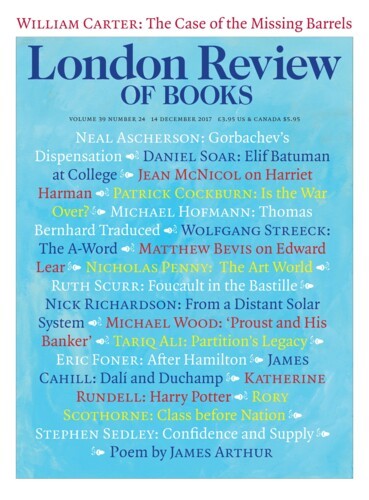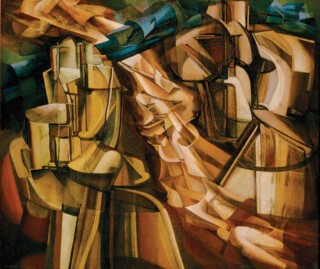A black and white photograph from 1958 shows Marcel Duchamp and Salvador Dalí on a hot August day in Cadaqués, on the east coast of Spain. The artists are trekking uphill with their wives, Alexina (‘Teeny’) Duchamp and Gala. Duchamp is in shorts and a straw hat; Dalí is dressed like a toreador in a white suit, clutching a gnarled staff. The image says something about their different styles – Duchamp’s cool asceticism, Dalí’s camp showmanship. They make an odd couple. But as the Royal Academy’s exhibition Dalí/Duchamp (until 3 January) makes clear, their lives and interests ran in close parallel from their first meeting, around 1930.
If Duchamp was ‘Dada’s Daddy’, as the critic Winthrop Sargeant proposed in Life magazine in 1952, then Dalí (17 years his junior) was Dada’s deranged and errant offspring. Both artists played up to their roles. Duchamp cultivated an aura of indifference and detachment, which culminated in his (disingenuous) abandonment of art in favour of chess in 1923. He continues to be lavished with scholarly veneration as the father of conceptual art. Dalí, if not quite a pariah of art history, has long been regarded with a certain embarrassment, as frivolous and unfashionable.
This image hasn’t been helped by Dalí’s right-wing leanings (the Royal Academy curators cautiously refer to his ‘resistance to politics’), and, later in life, his brazen commercialism: the lowest point was his series of TV adverts for Lanvin chocolates and Alka-Seltzer in the 1960s and 1970s. When visiting Duchamp on holiday in Cadaqués, Richard Hamilton and John Cage would try to avoid having to meet Dalí, whose villa was close by, and their hauteur is still felt by art historians and curators: Dalí was marginalised at the Hayward Gallery’s Undercover Surrealism exhibition in 2006, and at Tate Modern’s Duchamp, Man Ray, Picabia in 2008.
That the pairing may seem a strange one – despite their friendship and collaboration – is testament to the different ways in which both artists have been typecast. The curators are keen to point out that each was mercurial from the start, assuming identities and casting them off just as quickly. This finds comic expression in Duchamp’s photographic self-portraits as Rrose Sélavy (‘Eros, c’est la vie’), his female alter ego, and in Multiple Portrait of Marcel Duchamp (1917), in which the pensive pipe-smoking artist is multiplied, using mirrors, into five clones around a table. A similar air of playacting is discernible in any number of photographs of Dalí, preening or ogling at the camera.
From a brief survey of the exhibition, which moves from figurative paintings to sculptural ‘readymades’ to films such as Dalí and Buñuel’s L’Age d’or and Duchamp’s spinning ‘rotoreliefs’ (precursors to Op Art), one could be forgiven for thinking that the display was the work of ten artists, not two. Dalí’s painting The Lane to Port L-ligat (1922-23), a pleasant vista along a sun-dappled path, shows how derivative and tame his earliest work was. Untitled, from five years later, is a near monochrome canvas interrupted by slicks of black and white – like floaters on the retina – and what looks like a baby’s bottle sketched in graphite. Neither painting looks like a ‘Dalí’.
A work by Duchamp hung nearby is equally surprising – a thick-daubed painting of a carving of St Sebastian (1909). It is one of a number of early paintings by Duchamp in the first room. These have often suffered from being subordinated to the ‘Duchamp story’ – becoming flashpoints in his progression from Cubism and Futurism towards a complete rejection of painting by 1915. It is almost a relief to find that Nude Descending a Staircase No. 2 (1912), his masterpiece of fractured motion, is absent. Other works which prefigure it are accorded their own moment. The King and Queen Surrounded by Swift Nudes (1912), which Dalí later identified as presaging his own work, depicts a mechanistic bundle of walnut-coloured shards: even as a Cubist painter in brown, Duchamp was a master of elegance. In Portrait of Chess Players (1911), two human profiles can be glimpsed amid the caramel facets; this picture finds an echo, later in the show, in Dalí’s canvas Two Pieces of Bread Expressing the Sentiment of Love (1940) – possibly an allegory, in still life, of himself and Gala and Duchamp.
Both artists were fickle and dissembling. Neither can be aligned meaningfully with art-historical subsets – not even the anarchism of Dada or its close relative Surrealism. Duchamp was a formative influence on Surrealism and yet kept his distance from the inner circle, while Dalí – an enthusiast – came to be regarded with hostility. (André Breton, the movement’s official leader and manifesto-writer, excluded him in 1939 on the grounds of his ‘sympathies for Roman Catholicism and the fascism of Madrid’.) The dialogues which this exhibition constructs emphasise the artists’ mutual nonconformity rather than their adherence to creeds or governing concepts. Some of these exchanges were knowing and explicit. In 1953-54, Dalí collaborated in a pastiche of Duchamp’s infamous defacement of the Mona Lisa, L.H.O.O.Q. (1919), in which Lisa del Giocondo has been given a moustache (the title is a pun: ‘Elle a chaud au cul’). Dalí’s parody of Duchamp’s parody shows Dalí’s moustachioed face transplanted onto the Mona Lisa, a pile of gold coins spilling out of his (or her) hands. Breton had given Dalí the nickname ‘Avida Dollars’; in his nod to Duchamp, Dalí was also giving the high priest of Surrealism the finger.
The suggestion of an unlikely, conspiratorial allegiance between the two artists is played out in a large glass cabinet at the centre of the show – a hall of readymades. The notorious upturned urinal signed ‘R. Mutt’ sits beside Dalí’s Lobster Telephone (1936), in what ought to be a collision between thudding literalism and Surrealist metamorphosis. But they have more in common than it may seem. The material allure of the gleaming black phone is matched by the smooth porcelain of the urinal, and this superficial chiming points to the fact that Duchamp’s readymades were also meant to appeal to the senses and the imagination (as the poet Louise Norton saw in 1917, likening the urinal to a seated Buddha).
Such juxtapositions strip away the veneer of solemnity that has accrued over much of Duchamp’s art. The readymades are often characterised as the end of representation. (Duchamp’s sister disposed of the earliest examples – an upturned bicycle wheel and bottle rack – before the artist, writing to her from New York, had the chance to confer on them the status of the ‘tout fait’ in 1915.) And yet, seen in close quarters with Dalí’s showier, sillier concoctions, it is clear that Duchamp’s readymades were as much ‘surreal objects’ as real ones. The point is reinforced by the fact that few of the surviving objects are ‘readymades’ at all: Duchamp secured their fame and visibility by licensing replicas of them.
In both artists’ hands, found objects became jeux d’esprit. Duchamp’s hat rack and snow shovel are hung rakishly from a beam, just as in his New York studio in 1918. The strung-up implements have a slapstick appeal, due in part to their strange anthropomorphism. The design of the exhibition at large is tricksy and immersive, alternating between light and dark-walled rooms, with artfully placed mirrors doubling the apparent size of the cabinet of readymades – multiplying the multiples – in a conscious echo of the clutter and caprice of the Surrealist exhibitions of the 1930s and 1940s. Duchamp and Dalí worked closely on the International Surrealist Exposition of 1938 in Paris, and a side gallery at the RA contains a miniature recreation of Duchamp’s installation of 1200 sacks of coal (actually stuffed with newspaper) hung from the ceiling, in a dim brazier-lit space.
What these two artists shared more than anything was a sense of theatre – especially the theatricality of the commonplace. This is most obvious in their evocations of sex as a masquerade, a comedy of manners, or a matter of elaborate sublimation. Duchamp’s Large Glass (1915-23) is an allegory of erotic union between a ‘bride’ and her ‘bachelors’, represented by an inverted female figure above an array of mechanical male performers (a coffee grinder, water mill, and scissors and sieves). He said at the end of his life: ‘Eroticism was a theme, even an “ism” of everything I was doing at the time of The Large Glass.’ For twenty years, between 1946 and 1966, he worked in secret on the erotic peepshow diorama Etant donnés (Dalí may have been one of the few who knew about it), represented here by an assortment of studies. Dalí’s symbolism tended to be less oblique. Anthropomorphic Beach (1928) is a miniature relief made from painted cork, sponge and wood, in which a fragmentary finger gestures towards a cleft crimson sponge.
Send Letters To:
The Editor
London Review of Books,
28 Little Russell Street
London, WC1A 2HN
letters@lrb.co.uk
Please include name, address, and a telephone number.


